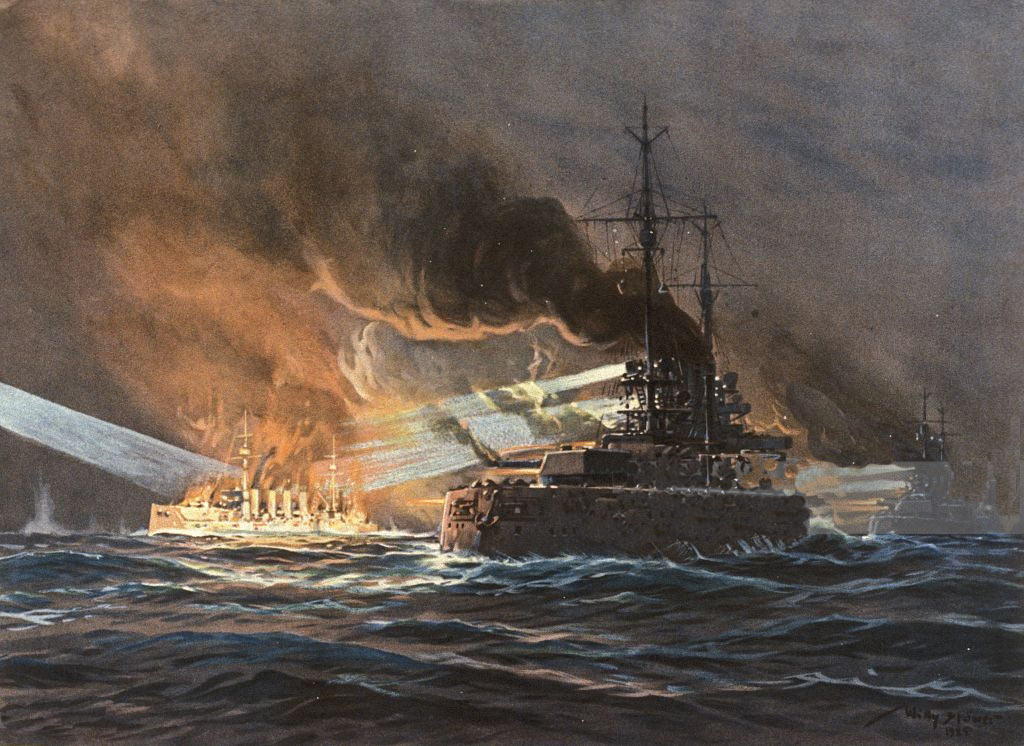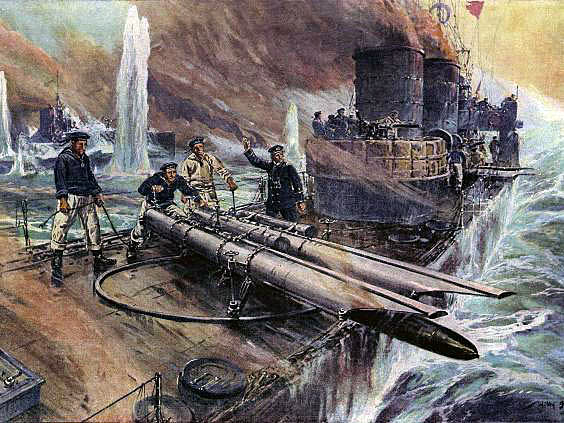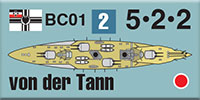Jutland: North Sea 1914
Author’s Notes
by Mike Bennighof, Ph.D.
November 2023
 Avalanche Press is an unusual entity among wargame publishers, a creator-owned outfit (this is pretty common in comics and role-playing publishing). That means that we can sometimes do unusual things, to indulge my whims and make a different sort of wargame. Avalanche Press is an unusual entity among wargame publishers, a creator-owned outfit (this is pretty common in comics and role-playing publishing). That means that we can sometimes do unusual things, to indulge my whims and make a different sort of wargame.
One of my fixations is to use the wargame format to build a historical narrative: to tell the story of an event (in this case, a war, campaign, or battle) through the game. A few years ago, I wrote a book we gave the clunky title of “Jutland Battle Analysis” in an effort to add some of that to ourGreat War at Sea: Jutland game. I went through all of Jutland’s 1914 scenarios, splitting them into chapters based on some key event. For each of them I added a battle analysis, discussing how the scenario reflected the historical events on which it was based. And then I fleshed them out with additional scenarios, many additional scenarios, and historical text, all to create a story of the 1914 naval campaign in the North Sea.
And then it came time to update Jutland, the game, to match our new Second Edition series rules for Great War at Sea. All I had to do was update the scenarios, but instead, I threw them all out and wrote new ones. This is one of the weaknesses of the creator-owned business; sometimes the creator does impulsive things.
 The result is, at least to my eye, a great game – a blend of history and game-play with a coherent story told through the game scenarios, that shows rather than just tells. And you, the reader/player, help tell that story. You can play all the way through and see how the Jutland campaign unfolded, you can pick up the action at a key point and see how you would have done things better/differently, or you can just ignore all the pretentious crap and play the damned game. The result is, at least to my eye, a great game – a blend of history and game-play with a coherent story told through the game scenarios, that shows rather than just tells. And you, the reader/player, help tell that story. You can play all the way through and see how the Jutland campaign unfolded, you can pick up the action at a key point and see how you would have done things better/differently, or you can just ignore all the pretentious crap and play the damned game.
The original vision for Jutland, the game, had been to cover the entire breadth of the naval war in the North Sea and Baltic in World War One. By narrowing the focus to just the Battle of Jutland, I now had a lot of material left over. I combined the Jutland scenarios set in 1914, heavily revised to meet the new standard, the Anglo-German scenarios from the Battle Analysis (this was most of them), and some new ones in a book we’re calling Jutland: North Sea 1914.
Great War at Sea is a relatively simple game system, compared to other specialty wargames (it’s pretty complex compared to mass-market games, even those with a historical theme slathered on). Great War at Sea shows the events through the outcome, without detailed processes that pretend to historical verisimilitude but usually only involve rolling lots of dice and looking at lots of tables. That simplicity makes it ideal for making a historical study of the events it portrays (and for using “verisimilitude” in a sentence).
 There’s an odd conceit among some wargamers, one I’ve seen for many years, that wargames represent scholarship just like a monograph (that’s academic for “book”) and are filled with research and analysis just like a peer-reviewed work of history. And that’s just not true. Often, even the best examples are simple antiquarian studies (“just the facts”), though sometimes impressively done. Even the very best of them (from a historian’s perspective) have their research and analysis presented in abstract unit strengths and leader ratings and whatever else. There are no footnotes on a Tiger II counter. There’s an odd conceit among some wargamers, one I’ve seen for many years, that wargames represent scholarship just like a monograph (that’s academic for “book”) and are filled with research and analysis just like a peer-reviewed work of history. And that’s just not true. Often, even the best examples are simple antiquarian studies (“just the facts”), though sometimes impressively done. Even the very best of them (from a historian’s perspective) have their research and analysis presented in abstract unit strengths and leader ratings and whatever else. There are no footnotes on a Tiger II counter.
With that said, you can learn some things with a wargame that you just can’t by reading a book, and that’s what I’m after with the new generation of Great War at Sea books and games: tell the story with both text and scenarios. That means taking a close look at the operations (chiefly, but not solely, British “sweeps” of the North Sea) that could have led to battles, or the battles that could have arisen from those operations.
Without those latter scenarios, it’s not possible to get a full picture of the campaign. To tell the full story, sometimes you have to talk about what could have happened, but did not, to show what the participants either hoped to accomplish or feared might happen. Sometimes that can make vague assumptions crystal clear.
One of the things you can learn from North Sea 1914 is that the German High Seas Fleet commander, Friedrich von Ingenohl, gets a raw deal in the many books published in the century following the Great War’s end. Daniel Allen Butler, in Distant Victory, writes of Ingenohl’s “natural timidity.” Keith Yates, in Flawed Victory, calls him “defensive-minded, timid, and indecisive” (italics are his). The list goes on; even Wikipedia piles on.
What becomes obvious when you play through the North Sea 1914 scenarios is that those two gentlemen, and many others, are completely wrong. Ingenohl was not timid; he was taking nearly-suicidal risks with a fleet including (by Imperial order) floating deathtraps that could neither inflict any damage on the British nor survive a single broadside from a new dreadnought.

You needed to be brave to man a German torpedo boat (yes, they were that small).
German naval intelligence didn’t even know where the Grand Fleet had gone for its war station. Eventually they realized it had gone north, but they did not identify Scapa Flow in the Orkney Islands north of Scotland as its base until months after the war began. And Britain’s Grand Fleet wasn’t just larger than the High Seas Fleet. It had a decided edge in heavy ships (battleships and battle cruisers) and the later dreadnoughts had greater firepower than their German counterparts.
The newest German ships were harder to sink than equivalent British ships, but Ingenohl didn’t just have the newest ships. The Admiralstab and the Kaiser insisted that all of the fleet’s battleships be made operational and added to the High Seas Fleet. The German pre-dreadnoughts were poor fighting ships, and the oldest classes carried nothing heavier than aged 240mm (9.4-inch) guns. The ancient coast-defense ships, relatively tiny vessels with the speed of a garbage scow and the armor of a beer can, even went to sea in some of these early operations on Kaiser Wilhelm’s insistence.
Even the earliest dreadnoughts weren’t very good. The German Navy came late to turbine propulsion, and it’s possible that the British suppliers of Germany’s first turbines sold them sub-standard goods. The first two classes of dreadnoughts carried the older triple-expansion engines, and the Nassau class was no faster than the pre-dreadnoughts.
That means that, in game terms, the German player’s fleet will not only have fewer ships mounting fewer guns, it always be slower than the British player’s fleet. Even worse, in the early-war scenarios the German player is often dragging along up to eighteen ships that have no primary guns, have a speed of 1 Slow (or worse), and have either three hull boxes with heavy armor or two with light armor (if you haven’t played Great War at Sea yet, that means that a new British dreadnought like Iron Duke will steam circles around them before vaporizing them, all while dreading naught of the spitballs they sling back in response).
Ingenohl was right to fear Sir John Jellicoe’s Grand Fleet. He couldn’t face them head-on, but had to find a way to engage just part of the British fleet. Many of the scenarios reflect Ingenohl’s attempts to do just that - and he made plenty of attempts. Ingenohl wasn’t avoiding battle; he was avoiding annihilation.
North Sea 1914 is unique. No one else makes books like these. If you’re in it for the history, then this is exactly what you’ve been looking for.
You can order North Sea 1914 right here.
The Jutland Experience
 Jutland Second Edition (full game) Jutland Second Edition (full game)
Jutland: North Sea 1914
Jutland: Dogger Bank
Journal No. 46: Iron Dogs
Retail Price: $179.96
Package Price: $150.00
Gold Club Price: $120.00
You can order the Jutland Experience right here.
Please allow an extra two weeks for delivery.
Sign up for our newsletter right here. Your info will never be sold or transferred; we'll just use it to update you on new games and new offers.
Mike Bennighof is president of Avalanche Press and holds a doctorate in history from Emory University. A Fulbright Scholar and NASA Journalist in Space finalist, he has published a great many books, games and articles on historical subjects; people are saying that some of them are actually good.
He lives in Birmingham, Alabama with his wife, three children, and his new puppy. His Iron Dog, Leopold, could swim very well.
Want to keep Daily Content free of third-party ads? You can send us some love (and cash) through this link right here.
|
